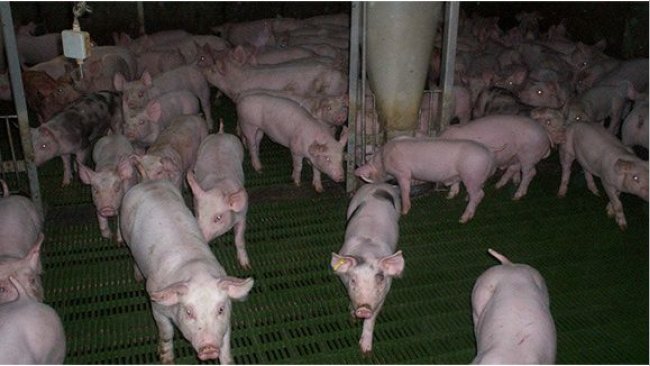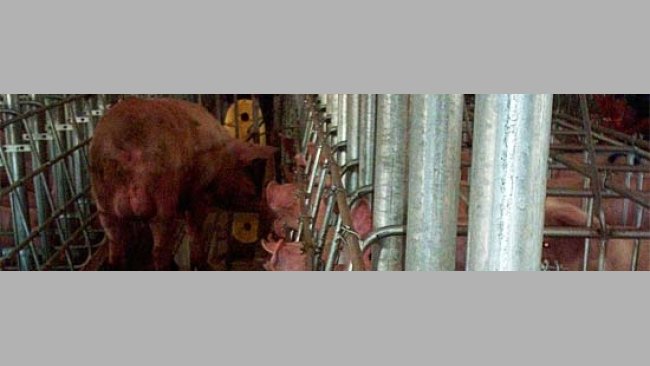
Farrowing induction IV: Guidelines
In this chapter we will take a look at some other aspects of farrowing induction...
The pig sector events all around the world
Weekly newsletter with all the pig333.com updates
Swine industry news in your email
Pig health: news and articles on PRRS, PCV2, biosecurity, etc, Pig disease guide, atlas of pathology, clinical cases…
Biocheck.UGent is an independent, risk-based, scientific scoring system for assessing the quality of your on-farm biosecurity.
A visual and practical step-by-step guide on how to perform a necropsy on a pig.
All the information about ASF: how to recognize the disease, how it is transmitted, pictures of lesions, latest news, guides, etc.
Description of the most important diseases and conditions in pigs
Images of major swine diseases
Pig disease diagnostic tool
Definition for the most commonly used pig terms
Simulator that calculates the amount of drug to add to the water when using a flow dispenser.
Weekly newsletter with all the pig333.com updates
Pig Prices by countries. Pork production and trade. News of the pig market and the raw materials
The latest slaughter pig prices in the most important pig markets. Check the evolution of the historical prices in charts and in several currencies.
Latest quotations for the main commodities used in pig feed. Historical graphs with the pig price and estimated feed price.
Figures & trends in pig numbers, pork production and pork trade.
Global production and trade data for the most important raw materials
Weekly newsletter with all the pig333.com updates
Articles on nutrition and pig feeding, characteristics of raw materials and additives for pig feed. Prices of raw materials
Latest quotations for the main commodities used in pig feed. Historical graphs with the pig price and estimated feed price.
Technical sheets of the main raw materials and additives used in swine feed. They include a comparison of nutritional values from various sources, product
Global production and trade data for the most important raw materials
Definition for the most commonly used pig terms
Use this tool to diagnose problems with the feed conversion ratio. Click on the flowchart or on the buttons within the text to navigate through the different parts of the tool.
A biweekly newsletter with the latest developments in swine nutrition
Articles on genetics and pig reproduction: genetic improvement, genomics, artificial insemination, use of hormones
Compare production data, calculate the number of sow, nursery, and finishing spaces, and visualize your tasks on the work schedule by type of BMS.
Tool that allows you to calculate the replacement rate in your farm
Definition for the most commonly used pig terms
Use this tool to find out why your farrowing rate is less than ideal. Click on the flowchart or on the buttons found within the text to navigate through the different parts of the tool.
Weekly newsletter with all the pig333.com updates
Management, pig farm management, work planning in each production stage: management in gestation, grow finish, batch farrowing
Compare production data, calculate the number of sow, nursery, and finishing spaces, and visualize your tasks on the work schedule by type of BMS.
Tool that allows you to calculate the replacement rate in your farm
Definition for the most commonly used pig terms
Weekly newsletter with all the pig333.com updates
Design of facilities and equipment for pig farms: building design, climate control, feeding systems, etc.
Biocheck.UGent is an independent, risk-based, scientific scoring system for assessing the quality of your on-farm biosecurity.
Environmental Footprint Calculator along the pork value chain.
Definition for the most commonly used pig terms
Simulator that calculates the amount of drug to add to the water when using a flow dispenser.
Use this tool to explore which slurry management strategy best fits your situation. Click on the flow chart or on the buttons within the text to navigate through the different parts of the tool.
Weekly newsletter with all the pig333.com updates
What makes us stand out is the quality and independence of our contents. Find out about the authors who make it possible. Our goal is to generate a virtual community of advanced users in the sector.

Since graduating he has worked as a swine consultant, concentrating mainly on:
He has participated in several seminars for farmers and veterinarians at a national and international level, and he has published many articles and case studies, mainly for Pig333 (3tres3) and the magazine Suis.
In September of 2014 he joined IDT Biologika's international team to manage its technical services in Spain and Portugal.
In July of 2019 he joined the CEVA Animal Health technical service team.
Updated CV 23-Jun-2020

In this chapter we will take a look at some other aspects of farrowing induction...

This may be a good option when farrowings and litter control during the first days are the priority.

On small farms it is better to group tasks on specific days, leaving other days with less tasks in order to organize days off...

It is practically impossible to inspect all the pigs individually during routine control visits.

In the last decades the degree of technification and evolution of the productive systems at all levels has been constant.

On large farms, it is common to wean more than once per week. This way, tasks can be homogenized throughout the week: each day will have a similar volume of work as the previous day.

A large part of the work on a swine farm can be divided into 3 key tasks: weaning, mating and farrowing. The day chosen for weaning determines the other two tasks; first, the matings, and then, as a consequence, the farrowings (the 2 ‘great events’ of which productivity of a farm depends on).

In the last chapter we examined mating guidelines that came rather close to being ideal, given that they achieve the following objectives: At least one mating should be adjusted to meet the ideal time and achieve the first objective with the least number of matings.

The ideal mating guideline should follow 2 objectives: At least one mating should be adjusted to meet the ideal time and achieve the first objective with the least number of matings.

As mentioned in the previous chapter, theoretically, the ideal mating time is around 10-12 hours before ovulation.


The optimal fertilization of a sow depends on several factors, among them, mating in a specific moment of the oestrus.

As mentioned in the first chapter of planning weaning, after deciding which sows are going to be weaned, on weaning day we must take into account several factors...


In swine, dystocia is usually caused by oversized piglets (or by a narrow birth canal) instead of foetal positioning problems.

A correct supervision is one of the key points of a farrowing.
Welcome to 333
Connect, share, and interact with the largest community of professionals in the swine industry.
Celebrating 169014Users on 333!
Sign upAlready a member?





